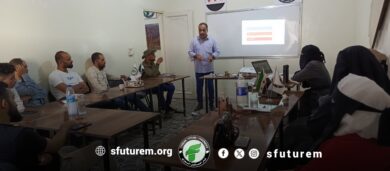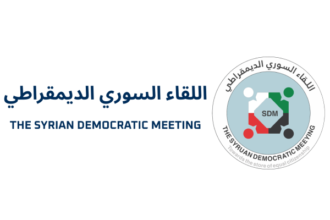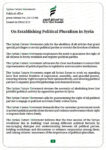Centralization and decentralization, and the third option between them

It appears evident to anyone familiar with Syrian affairs that there is a clear dispute among Syrian military forces, particularly between the Kurdish Autonomous Administration (SDF) and the new Syrian administration in Damascus regarding the new governance system in Syria—whether it should be centralized or decentralized. From the areas under the Interim Government to the southern forces in Suwayda and Daraa, there are varying perspectives that differ from the vision of the new Syrian administration, which seeks to dissolve all military factions into the Ministry of Defense and integrate all civil administrations into state institutions. In this context, Hay’at Tahrir al-Sham is attempting to dissolve itself within this framework under the notion that “He who equates you with himself has not wronged you.”
It can be said that the repeated delays of the National General Assembly (or whatever name one may choose) are primarily due to this issue, as each party remains firmly committed to its position. What we truly fear most is that this disagreement might escalate into a crisis, pushing Syria into a phase similar to the previous period of turmoil during Assad’s rule—even though the difference between the two periods is vast.
Given both sides’ stubbornness in holding their positions, it seems difficult to propose a middle-ground solution that could satisfy both parties. However, adopting a “joint governance” system could be considered, where power is shared between the national government and local administrations, potentially reconciling centralization and decentralization.
The Syrian Future Movement believes that this system could strengthen Syria’s stability and unity amid political divisions and contribute to sustainable development.
We also view the “joint governance” or “cooperative federalism” system as a possible middle-ground solution that balances centralization and decentralization. It is sometimes referred to as the “shared decentralization system.”
Definition of the Joint System: It is a hybrid approach that combines elements of centralized and decentralized governance, aiming to balance the central authority in the capital with local administrations in regions or provinces.
Distribution of Powers:
- Central Government: It retains key powers related to foreign policy, defense, the national economy, and major legislation. This ensures a unified authority capable of addressing major national issues and preserving state sovereignty.
- Local Administrations: They have broad powers over local governance, such as education, healthcare, local development, and local financial management. This allows regions to manage their own affairs and achieve sustainable development according to their specific needs.
Global Examples:
- A- Germany: Germany is a successful model of joint governance, where the states have broad authority over local affairs while the federal government retains significant powers at the national level.
- B- Switzerland: Switzerland is also a good example, as it relies on a decentralized system that encourages participation and cooperation between the cantons and the federal government.
Hence, we believe that there are potential benefits to implementing a joint governance system in Syria, such as:
- Achieving a balance between the interests of the center and the regions, which enhances political stability.
- Encouraging greater citizen participation in local decision-making, which strengthens the sense of belonging and responsibility.
- Reducing conflicts between the central government and local administrations by providing clear mechanisms for coordination and cooperation.
Challenges and Difficulties:
Undoubtedly, there are many challenges, but it seems that there are two main issues that need to be resolved, and solving others would be easier:
- Implementation: The implementation of this system may be complex and require the development of strong institutional capacities. This is new to the Syrian mindset, which may lack the necessary training and organization, potentially hindering the success of this system.
- Mutual Trust: It requires building mutual trust between the various parties to ensure effective cooperation. We are aware of the scale of the conflict between the east and west of the Euphrates, particularly the negative relationship between the Syrian Democratic Forces (SDF) and Turkey, along with the constant rejection of any expansion or further encroachment by the SDF. This may be interpreted as a rejection of such a system in that region, leading to the continued Turkish-SDF hostility, which in turn perpetuates the tension within the National Army and ultimately results in the failure to engage due to a lack of trust in this joint governance system.
The Difference Between Cooperative Federalism and Administrative Decentralization:
Proponents of administrative decentralization often try to claim that their system is similar to cooperative federalism or shared decentralization. However, upon investigation, we find there are significant differences. Cooperative federalism and administrative decentralization are two distinct models of governance and power distribution between the central government and local entities.
The difference between them is evident as follows:
A. Cooperative Federalism:
- Definition: As previously mentioned, cooperative federalism is a system of governance where power is divided between the federal (central) government and regional (local) governments in a collaborative manner. In this system, different governments work together to achieve common goals and coordinate policies.
- Power Distribution: Power is distributed in a balanced manner between the central government and regional governments. Regional governments have extensive authority in areas such as education, health, and local development. Both central and regional governments work together in certain areas to achieve balance and cooperation.
- Cooperation and Coordination: This system relies on continuous cooperation and coordination between the central government and regional governments through joint councils or committees. Shared policies are adopted, and decisions are made through consultations between the different levels of government.
B. Administrative Decentralization:
- Definition: Administrative decentralization is a system of governance in which power is transferred from the central government to local administrative units, such as provinces or municipalities. The aim of this system is to improve administrative efficiency and bring services closer to the citizens.
- Distribution of power: The central government retains primary authority, but some executive and administrative powers are transferred to local governments. Local governments are also required to implement policies and procedures set by the central government.
- Coordination and supervision: The central government remains the primary overseer and coordinates policies at the national level, while local governments implement policies and deliver services according to the central government’s guidelines.
- Examples: France and Italy are examples of administrative decentralization. In both countries, local governments have executive powers, but the central government retains the main legislative authority.
C. The Fundamental Difference:
- The cooperative federalism relies on a balanced division of power between the center and the regions, focusing on cooperation and coordination between them.
- Administrative decentralization relies on transferring executive powers to local governments, while the central government retains primary authority and general directives.
Therefore, we believe that adopting a system that combines elements of cooperative federalism and administrative decentralization could be a middle ground to achieve a balance between centralization and decentralization in Syria, while ensuring continuous cooperation and coordination between the central government and local administrations.
Political Office
Jomaa Mohammad Laheep
Research and Studies Department
Articles
Syrian Future Movement






